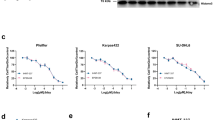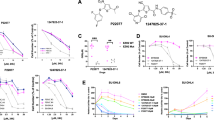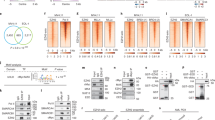Abstract
The enhancer of zeste homolog 2 (EZH2) is the main enzymatic subunit of the PRC2 complex, which catalyzes trimethylation of histone H3 lysine 27 (H3K27me3) to promote transcriptional silencing. EZH2 is overexpressed in multiple types of cancer including triple-negative breast cancer (TNBC), and high expression levels correlate with poor prognosis. Several EZH2 inhibitors, which inhibit the methyltransferase activity of EZH2, have shown promise in treating sarcoma and follicular lymphoma in clinics. However, EZH2 inhibitors are ineffective at blocking proliferation of TNBC cells, even though they effectively reduce the H3K27me3 mark. Using a hydrophobic tagging approach, we generated MS1943, a first-in-class EZH2 selective degrader that effectively reduces EZH2 levels in cells. Importantly, MS1943 has a profound cytotoxic effect in multiple TNBC cells, while sparing normal cells, and is efficacious in vivo, suggesting that pharmacologic degradation of EZH2 can be advantageous for treating the cancers that are dependent on EZH2.
This is a preview of subscription content, access via your institution
Access options
Access Nature and 54 other Nature Portfolio journals
Get Nature+, our best-value online-access subscription
$29.99 / 30 days
cancel any time
Subscribe to this journal
Receive 12 print issues and online access
$259.00 per year
only $21.58 per issue
Buy this article
- Purchase on Springer Link
- Instant access to full article PDF
Prices may be subject to local taxes which are calculated during checkout






Similar content being viewed by others
Code availability
The scripts used to analyze RNA-seq data and to produce some of the plots are available at https://github.com/parsonslabmssm/MS1943.
References
Cao, R. et al. Role of histone H3 lysine 27 methylation in polycomb-group silencing. Science 298, 1039–1043 (2002).
Kuzmichev, A., Nishioka, K., Erdjument-Bromage, H., Tempst, P. & Reinberg, D. Histone methyltransferase activity associated with a human multiprotein complex containing the enhancer of zeste protein. Genes Dev. 16, 2893–2905 (2002).
Margueron, R. & Reinberg, D. The polycomb complex PRC2 and its mark in life. Nature 469, 343–349 (2011).
Kim, K. H. & Roberts, C. W. M. Targeting EZH2 in cancer. Nat. Med. 22, 128–134 (2016).
Kaniskan, H. Ü., Martini, M. L. & Jin, J. Inhibitors of protein methyltransferases and demethylases. Chem. Rev. 118, 989–1068 (2018).
Konze, K. D. et al. An orally bioavailable chemical probe of the lysine methyltransferases EZH2 and EZH1. ACS Chem. Biol. 8, 1324–1334 (2013).
Yang, X. et al. Structure–activity relationship studies for enhancer of zeste homologue 2 (EZH2) and enhancer of zeste homologue 1 (EZH1) inhibitors. J. Med. Chem. 59, 7617–7633 (2016).
Knutson, S. K. et al. Durable tumor regression in genetically altered malignant rhabdoid tumors by inhibition of methyltransferase EZH2. Proc. Natl Acad. Sci. USA 110, 7922–7927 (2013).
Knutson, S. K. et al. A selective inhibitor of EZH2 blocks H3K27 methylation and kills mutant lymphoma cells. Nat. Chem. Biol. 8, 890–896 (2012).
McCabe, M. T. et al. EZH2 inhibition as a therapeutic strategy for lymphoma with EZH2-activating mutations. Nature 492, 108–112 (2012).
Vaswani, R. G. et al. Identification of (R)-N-((4-methoxy-6-methyl-2-oxo-1,2-dihydropyridin-3-yl)methyl)-2-methyl-1-(1-(1-(2,2,2-trifluoroethyl)piperidin-4-yl)ethyl)-1H-indole-3-carboxamide (CPI-1205), a potent and selective inhibitor of histone methyltransferase EZH2, suitable for phase I clinical trials for B-cell lymphomas. J. Med. Chem. 59, 9928–9941 (2016).
Kung, P. P. et al. Optimization of orally bioavailable enhancer of zeste homolog 2 (EZH2) inhibitors using ligand and property-based design strategies: identification of development candidate (R)-5,8-dichloro-7-(methoxy(oxetan-3-yl)methyl)-2-((4-methoxy-6-methyl-2-oxo-1,2- dihydropyridin-3-yl)methyl)-3,4-dihydroisoquinolin-1(2H)-one (PF-06821497). J. Med. Chem. 61, 650–665 (2018).
Xu, K. et al. EZH2 oncogenic activity in castration-resistant prostate cancer cells is polycomb-independent. Science 338, 1465–1469 (2012).
Zhao, Y. et al. EZH2 cooperates with gain-of-function p53 mutants to promote cancer growth and metastasis. EMBO J. 38, e99599 (2019).
Kim, J. et al. Polycomb- and methylation-independent roles of EZH2 as a transcription activator. Cell Rep. 25, 2808–2820 (2018).
Lin, N. U. et al. Clinicopathologic features, patterns of recurrence and survival among women with triple-negative breast cancer in the national comprehensive cancer network. Cancer 118, 5463–5472 (2012).
Lara-Medina, F. et al. Triple-negative breast cancer in Hispanic patients: high prevalence, poor prognosis and association with menopausal status, body mass index and parity. Cancer 117, 3658–3669 (2011).
Gluz, O. et al. Triple-negative breast cancer—current status and future directions. Ann. Oncol. 20, 1913–1927 (2009).
Kleer, C. G. et al. EZH2 is a marker of aggressive breast cancer and promotes neoplastic transformation of breast epithelial cells. Proc. Natl Acad. Sci. USA 100, 11606–11611 (2003).
Varambally, S. et al. The polycomb group protein EZH2 is involved in progression of prostate cancer. Nature 419, 624–629 (2002).
Holm, K. et al. Global H3K27 trimethylation and EZH2 abundance in breast tumor subtypes. Mol. Oncol. 6, 494–506 (2012).
Bracken, A. P. et al. EZH2 is downstream of the pRB‐E2F pathway, essential for proliferation and amplified in cancer. EMBO J. 22, 5323–5335 (2003).
Bachmann, I. M. et al. EZH2 expression is associated with high proliferation rate and aggressive tumor subgroups in cutaneous melanoma and cancers of the endometrium, prostate and breast. J. Clin. Oncol. 24, 268–273 (2006).
Ding, L., Erdmann, C., Chinnaiyan, A. M., Merajver, S. D. & Kleer, C. G. Identification of EZH2 as a molecular marker for a precancerous state in morphologically normal breast tissues. Cancer Res. 66, 4095–4099 (2006).
Gonzalez, M. E. et al. Downregulation of EZH2 decreases growth of estrogen receptor-negative invasive breast carcinoma and requires BRCA1. Oncogene 28, 843–853 (2009).
Yang, X. et al. CDKN1C (p57KIP2) is a direct target of EZH2 and suppressed by multiple epigenetic mechanisms in breast cancer cells. PLoS One 4, e5011 (2009).
Chang, C. J. et al. EZH2 promotes expansion of breast tumor initiating cells through activation of RAF1-beta-catenin signaling. Cancer Cell 19, 86–100 (2011).
Curry, E. et al. Dual EZH2 and EHMT2 histone methyltransferase inhibition increases biological efficacy in breast cancer cells. Clin. Epigenetics 7, 84 (2015).
Lai, A. C. & Crews, C. M. Induced protein degradation: an emerging drug discovery paradigm. Nat. Rev. Drug Discov. 16, 101–114 (2017).
Burslem, G. M. & Crews, C. M. Small-molecule modulation of protein homeostasis. Chem. Rev. 117, 11269–11301 (2017).
Neklesa, T. K. & Crews, C. M. Greasy tags for protein removal. Nature 487, 308–309 (2012).
Xie, T. et al. Pharmacological targeting of the pseudokinase Her3. Nat. Chem. Biol. 10, 1006–1012 (2014).
Justin, N. et al. Structural basis of oncogenic histone H3K27M inhibition of human polycomb repressive complex 2. Nat. Commun. 7, 11316 (2016).
Brooun, A. et al. Polycomb repressive complex 2 structure with inhibitor reveals a mechanism of activation and drug resistance. Nat. Commun. 7, 11384 (2016).
Fong, J. Y. et al. Therapeutic targeting of RNA splicing catalysis through inhibition of protein arginine methylation. Cancer Cell 36, 194–209 (2019).
Xu, B. et al. Selective inhibition of EZH2 and EZH1 enzymatic activity by a small molecule suppresses MLL-rearranged leukemia. Blood 125, 346–357 (2015).
Hetz, C., Chevet, E. & Harding, H. P. Targeting the unfolded protein response in disease. Nat. Rev. Drug Discov. 12, 703 (2013).
Lee, A.-H., Iwakoshi, N. N. & Glimcher, L. H. XBP-1 regulates a subset of endoplasmic reticulum resident chaperone genes in the unfolded protein response. Mol. Cell Biol. 23, 7448–7459 (2003).
Yoshida, H., Matsui, T., Yamamoto, A., Okada, T. & Mori, K. XBP1 mRNA is induced by ATF6 and spliced by IRE1 in response to ER stress to produce a highly active transcription factor. Cell 107, 881–891 (2001).
Cano-González, A., Mauro-Lizcano, M., Iglesias-Serret, D., Gil, J. & López-Rivas, A. Involvement of both caspase-8 and Noxa-activated pathways in endoplasmic reticulum stress-induced apoptosis in triple-negative breast tumor cells. Cell Death Dis. 9, 134 (2018).
Guo, S. et al. EZH2 overexpression in different immunophenotypes of breast carcinoma and association with clinicopathologic features. Diagn. Pathol. 11, 41 (2016).
Alford, S. H., Toy, K., Merajver, S. D. & Kleer, C. G. Increased risk for distant metastasis in patients with familial early-stage breast cancer and high EZH2 expression. Breast Cancer Res. Treat. 132, 429–437 (2012).
Szegezdi, E., Logue, S. E., Gorman, A. M. & Samali, A. Mediators of endoplasmic reticulum stress‐induced apoptosis. EMBO Rep. 7, 880–885 (2006).
Kim, W. et al. Targeted disruption of the EZH2–EED complex inhibits EZH2-dependent cancer. Nat. Chem. Biol. 9, 643–650 (2013).
Tan, J. et al. Pharmacologic disruption of polycomb-repressive complex 2-mediated gene repression selectively induces apoptosis in cancer cells. Genes Dev. 21, 1050–1063 (2007).
Lee, J.-K. & Kim, K.-C. DZNep, inhibitor of S-adenosylhomocysteine hydrolase, down-regulates expression of SETDB1 H3K9me3 HMTase in human lung cancer cells. Biochem. Biophys. Res. Commun. 438, 647–652 (2013).
Miranda, T. B. et al. DZNep is a global histone methylation inhibitor that reactivates developmental genes not silenced by DNA methylation. Mol. Cancer Ther. 8, 1579–1588 (2009).
Wang, X. et al. A covalently bound inhibitor triggers EZH2 degradation through ChIP‐mediated ubiquitination. EMBO J. 36, 1243–1260 (2017).
Kasibhatla, S. et al. A role for transferrin receptor in triggering apoptosis when targeted with gambogic acid. Proc. Natl Acad. Sci. USA 102, 12095–12100 (2005).
Baell, J. B. & Holloway, G. A. New substructure filters for removal of pan assay interference compounds (PAINS) from screening libraries and for their exclusion in bioassays. J. Med. Chem. 53, 2719–2740 (2010).
Manglik, A. et al. Structure-based discovery of opioid analgesics with reduced side effects. Nature 537, 185–190 (2016).
Patro, R., Duggal, G., Love, M. I., Irizarry, R. A. & Kingsford, C. Salmon provides fast and bias-aware quantification of transcript expression. Nat. Methods 14, 417–419 (2017).
Weinstein, J. N. et al. The Cancer Genome Atlas Pan-Cancer analysis project. Nat. Genet. 45, 1113–1120 (2013).
Soneson, C., Love, M. & Robinson, M. Differential analyses for RNA-seq: transcript-level estimates improve gene-level inferences. F1000Research 4, 1521 (2016).
Luo, W., Friedman, M. S., Shedden, K., Hankenson, K. D. & Woolf, P. J. GAGE: generally applicable gene set enrichment for pathway analysis. BMC Bioinformatics 10, 161 (2009).
Luo, W. & Brouwer, C. Pathview: an R/Bioconductor package for pathway-based data integration and visualization. Bioinformatics 29, 1830–1831 (2013).
Subramanian, A. et al. Gene set enrichment analysis: a knowledge-based approach for interpreting genome-wide expression profiles. Proc. Natl Acad. Sci. USA 102, 15545–15550 (2005).
Mootha, V. K. et al. PGC-1α-responsive genes involved in oxidative phosphorylation are coordinately downregulated in human diabetes. Nat. Genet. 34, 267–273 (2003).
Acknowledgements
This work was supported in part by grant no. R01CA230854 (to J.J. and R.P.) from the US National Institutes of Health. J.J. also acknowledges the support by grant no. R01CA218600 from the US National Institutes of Health and an endowed professorship by the Icahn School of Medicine at Mount Sinai. B.D. acknowledges support by the Medical Scientist Training Program (MSTP) training grant no. T32GM007280 at the Icahn School of Mount Sinai from the US National Institutes of Health. We thank the National Institute of Mental Health Psychoactive Drug Screening Program (NIMH-PDSP) for generating the selectivity data of MS1943 over GPCRs, ion channels and transporters. We also thank C. Lee (Icahn School of Medicine at Mount Sinai) and W. Ma (Memorial Sloan Kettering Cancer Center) for providing reagents for shRNA knockdown experiments. This work was supported in part through the computational resources and staff expertise provided by Scientific Computing at the Icahn School of Medicine at Mount Sinai. Research reported in this paper was supported by the Office of Research Infrastructure of the US National Institutes of Health under award no. S10OD018522. The content is solely the responsibility of the authors and does not necessarily represent the official views of the US National Institutes of Health.
Author information
Authors and Affiliations
Contributions
J.J. conceived the idea. A.M., E.S., R.P. and J.J. conceived and designed the experiments. A.M. and X.Y. synthesized the compounds. K.-S.P. and A.M. performed western blot experiments. E.S. performed the proliferation and apoptosis assays, qRT–PCR, immunohistochemistry and the in vivo experiment. T.C.M. analyzed the RNA-seq, tumor weight and drug concentration data. K.-S.P., J.W. and B.D. performed cell growth inhibition assays. A.M., V.L., A.L. and S.P. performed the RNA-seq experiment. M.S., A.R. and E.G. performed EZH2 KO experiments. J.W. and E.S. performed EZH2 KD experiments. K.-S.P. and E.S. performed mechanism of action studies. All authors discussed the results and commented on the manuscript. A.M., E.S., K.-S.P., R.P. and J.J. analyzed the data and co-wrote the paper. J.W. and T.C.M. contributed equally to this work.
Corresponding authors
Ethics declarations
Competing interests
J.J., R.P., A.M., E.S. and X.Y. are inventors for a patent application filed by the Icahn School of Medicine at Mount Sinai. J.J. is an equity shareholder and consultant of Cullgen.
Additional information
Publisher’s note Springer Nature remains neutral with regard to jurisdictional claims in published maps and institutional affiliations.
Supplementary information
Supplementary Information
Supplementary Figs. 1–22, Tables 1–3 and Supplementary Note.
Supplementary Video 1
Time-lapse pictures of MDA-MB-468 cells treated with DMSO. Cells were treated with DMSO for 3 days.
Supplementary Video 2
Time-lapse pictures of MDA-MB-468 cells treated with C24. Cells were treated with C24 (4 µM) for 3 days.
Supplementary Video 3
Time-lapse pictures of MDA-MB-468 cells treated with MS1943. Cells were treated with MS1943 (4 µM) for 3 d.
Supplementary Video 4
Time-lapse pictures of HCC1187 cells treated with DMSO. Cells were treated with DMSO for 3 d.
Supplementary Video 5
Time-lapse pictures of HCC1187 cells treated with C24. Cells were treated with C24 (4 µM) for 3 d.
Supplementary Video 6
Time-lapse pictures of HCC1187 cells treated with MS1943. Cells were treated with MS1943 (4 µM) for 3 d.
Supplementary Video 7
Time-lapse pictures of HCC70 cells treated with DMSO. Cells were treated with DMSO for 3 d.
Supplementary Video 8
Time-lapse pictures of HCC70 cells treated with C24. Cells were treated with C24 (4 µM) for 3 d.
Supplementary Video 9
Time-lapse pictures of HCC70 cells treated with MS1943. Cells were treated with MS1943 (4 µM) for 3 d.
Rights and permissions
About this article
Cite this article
Ma, A., Stratikopoulos, E., Park, KS. et al. Discovery of a first-in-class EZH2 selective degrader. Nat Chem Biol 16, 214–222 (2020). https://doi.org/10.1038/s41589-019-0421-4
Received:
Accepted:
Published:
Issue Date:
DOI: https://doi.org/10.1038/s41589-019-0421-4
This article is cited by
-
A miniaturized mode-of-action profiling platform enables high throughput characterization of the molecular and cellular dynamics of EZH2 inhibition
Scientific Reports (2024)
-
EZH2 K63-polyubiquitination affecting migration in extranodal natural killer/T-cell lymphoma
Clinical Epigenetics (2023)
-
UHRF1/UBE2L6/UBR4-mediated ubiquitination regulates EZH2 abundance and thereby melanocytic differentiation phenotypes in melanoma
Oncogene (2023)
-
Epigenetic mechanisms underlying subtype heterogeneity and tumor recurrence in prostate cancer
Nature Communications (2023)
-
EZH1/2 as targets for cancer therapy
Cancer Gene Therapy (2023)



